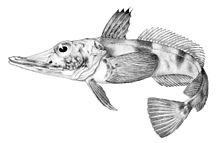
The notothens or cod icefishes are the family Nototheniidae of acanthopterygian fishes. They are traditionally placed in the order Perciformes together with their relatives, but like every lineage in the order, actual phylogenetic relationships among these species have not yet been determined with certainty.
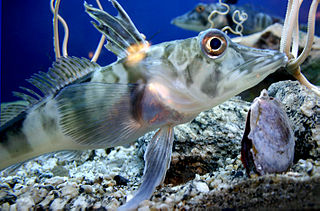
The crocodile icefish or white-blooded fish (Channichthyidae) comprise a family of notothenioid fishes found in the Southern Ocean around Antarctica. They are the only known vertebrates to lack hemoglobin in their blood as adults. Icefish populations are known to reside in the Atlantic and Indian sectors of the Southern Ocean as well as the continental shelf waters surrounding Antarctica. Water temperatures in these regions remain relatively stable, generally ranging from −1.8 to 2 °C. One icefish, Champsocephalus esox, is distributed north of the Antarctic Polar Frontal Zone. At least sixteen species of crocodile icefish are currently recognized, although eight additional species have been proposed for the icefish genus Channichthys.

The Antarctic fur seal, is one of eight seals in the genus Arctocephalus, and one of nine fur seals in the subfamily Arctocephalinae. Despite what its name suggests, the Antarctic fur seal is mostly distributed in Subantarctic islands and its scientific name is thought to have come from the German vessel SMS Gazelle, which was the first to collect specimens of this species from Kerguelen Islands.
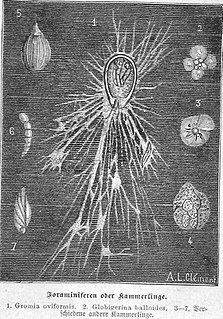
Gromia is a genus of protists, closely related to foraminifera, which inhabit marine and freshwater environments. Gromia are ameboid, producing filose pseudopodia that extend out from the cell’s proteinaceous test through a gap enclosed by the cell’s oral capsule. The test, a shell made up of protein that encloses the cytoplasm, is made up of several layers of membrane, which resemble honeycombs in shape — a defining character of this genus.
Icefishes or noodlefishes are a family, the Salangidae, of small osmeriform fish, related to the smelts. They are found in Eastern Asia, ranging from the Russian Far East in the north to Vietnam in the south, with the highest species richness in China. Some species are widespread and common, but others have relatively small ranges and are threatened. Depending on species, they inhabit coastal marine, brackish or fresh water habitats, and some are anadromous, only visiting fresh water to spawn.

The Antarctic silverfish is a species of notothen native to the Southern Ocean and the only truly pelagic fish in the waters near Antarctica. It is a keystone species in the ecosystem of the Southern Ocean.

Notothenioidei is one of 19 suborders from the order Perciformes and that primarily includes Antarctic fish and Subantarctic fish, but also a few species ranging north to southern Australia and southern South America. These species, which are referred to collectively as the notothenioids, account for approximately 90% of the fish fauna biomass in the continental shelf waters surrounding Antarctica.
Neosalanx tangkahkeii, the Chinese icefish or short-snout icefish, is a species of icefish endemic to fresh and brackish waters in China. Despite its common name it is not the only icefish in China; the majority of the species in this family are found in the country.
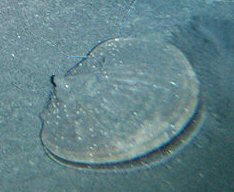
Adamussium is a monotypic genus of bivalve molluscs in the large family of scallops, the Pectinidae. The Antarctic scallop is the only species in the genus though its exact relationship to other members of the family is unclear. It is found in the ice-cold seas surrounding Antarctica, sometimes at great depths.

Galiteuthis glacialis is a species of glass squid from the Antarctic Convergence. It is in the cranchiidae family and subfamily taoniinae. They are endemic to the Antarctic and are found in the Southern Ocean, around the Weddell Sea and South Shetland Islands. Galiteuthis glacialis are one of the most plentiful and widely dispersed species of Antarctic squid. These squids are found in the mesopelagic and bathypelagic layers of the open ocean and demonstrate vertical migration. They can reach a maximum mantle length of 500 mm (0.5m).

Chionodraco is a genus of crocodile icefishes found in the Southern Ocean.

Neopagetopsis ionah, Jonah's icefish, is a benthopelagic species of crocodile icefish found in the Southern Ocean at depths of from 20 to 900 metres. It has a circum-Antarctic distribution on the continental slope and continental shelf, with the northernmost records from the South Shetland and the South Orkney Islands.

The ocellated icefish is a fish of the family Channichthyidae. It lives in the cold waters off Antarctica and is known for having transparent haemoglobin-free blood.

The wildlife of Antarctica are extremophiles, having to adapt to the dryness, low temperatures, and high exposure common in Antarctica. The extreme weather of the interior contrasts to the relatively mild conditions on the Antarctic Peninsula and the subantarctic islands, which have warmer temperatures and more liquid water. Much of the ocean around the mainland is covered by sea ice. The oceans themselves are a more stable environment for life, both in the water column and on the seabed.

Antarctic fish is a common name for a variety of fish that inhabit the Southern Ocean. There are relatively few families in this region, the most species rich-being the Liparidae (snailfishes), followed by Nototheniidae. The latter is one of five different families that belong to the suborder Notothenioidei of the order Perciformes. The other four are Artedidraconidae, Bathydraconidae, Channichthyidae and Harpagiferidae. They are also called notothenioids, but this name is also used to describe the other three, non-Antarctic families and some of the non-Antarctic genera in the mainly Antarctic families belonging to the suborder.

Notothenia coriiceps, also known as the black rockcod, Antarctic yellowbelly rockcod, or Antarctic bullhead notothen, is a species of notothen that is widely spread around the Antarctic continent. Like other Antarctic notothenioid fishes, N. coriiceps evolved in the stable, ice-cold environment of the Southern Ocean. It is not currently targeted by commercial fisheries.
Neolithodes capensis is a species of king crab which is found in the Southern Ocean and the western Indian Ocean. It has been found to a depth of 660–3,200 metres (2,170–10,500 ft).
Neolithodes diomedeae is a species of king crab which is found in the eastern Pacific Ocean, the southwestern Atlantic Ocean, and the Bellingshausen and Scotia Seas in the Southern Ocean.
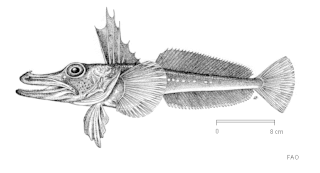
Channichthys rhinoceratus, the unicorn icefish, is a species of crocodile icefish found only around the Kerguelen-Heard Plateau in the Southern Ocean. It is a demersal species living from surface waters to depths up to 750 m (2,460 ft). It is considered by some researchers as the only species in the genus Channichthys.
Channichthys panticapaei, the charcoal icefish, is a species of crocodile icefish endemic to the Kerguelen Islands area in the Southern Ocean. This demersal species is found at depths of 112–154 m (367–505 ft) and is sometimes caught in bottom trawls. It is dark gray to uniformly blackish with long first to third dorsal fin spines. The charcoal icefish reaches lengths of up to 40.2 cm (15.8 in), with males generally being larger. This planktivorous (plankton-eating) species likely spawns from June to July.
